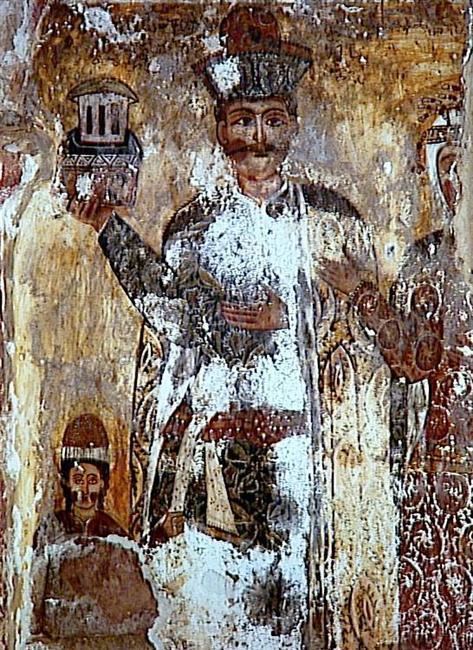Name Levan Dadiani | ||
 | ||
Levan I Dadiani (also Leon; Georgian: ლევან [ლეონ] I დადიანი; died 1572) was a member of the House of Dadiani and ruler of Odishi, that is, Mingrelia, in western Georgia. He succeeded on the death of his father, Mamia III Dadiani, as eristavi ("duke") of Odishi and ex officio mandaturt-ukhutsesi ("Lord High Steward") of Imereti in 1533. Dadiani's break with the king of Imereti brought about his downfall and imprisonment in 1546. He was able to escape and regain his possessions, securing Ottoman support for his independence from Imereti.
Contents
- Accession to power and break with the king of Imereti
- Imprisonment and escape
- Relations with Gurieli
- Exile to Constantinople and comeback
- Death and family
- References
Accession to power and break with the king of Imereti
Levan was a son of Mamia III Dadiani by his wife, Elisabed. He succeeded on Mamia's death in an expedition against the Circassians in 1533. These mountainous tribes from the North Caucasus continued to pose a challenge to Levan, but more immediate threat to his hold of power came from his overlords, the kings of Imereti, one of the three breakaway kingdoms of medieval Georgia. By the time of Levan's accession to power, the Dadiani had achieved significant autonomy and his contemporary king of Imereti, Bagrat III, was determined to bring the crown's recalcitrant subjects under control. Levan continued to be styled as eristavt-eristavi ("duke") of Mingrelia and mandaturt-ukhutsesi ("Lord High Steward") of Imereti, but by defying Bagrat's call to arms during a war waged by an alliance of Georgian rulers against the expanding Ottoman Empire in 1545, Levan reneged on his vestigial duties as a vassal to the king.
Imprisonment and escape
Bagrat, defeated by the Ottomans at Sokhoista, avenged Dadiani a year later: he invited Levan to a summit at Khoni, incarcerated him in Gelati's bell-tower, and offered his vassal, Rostom Gurieli of Guria to divide up Mingrelia. Gurieli, wary that he would be the next target of Bagrat's centralizing efforts, declined the offer and advised the king to release Dadiani. Around 1550, Bagrat's yet another foe, Kaikhosro II Jaqeli, Prince of Samtskhe, bribed the Imeretian nobleman Khopilandre Chkheidze to help Dadiani escape and then persuaded Gurieli to give him a free passage to Mingrelia, where Levan was quickly reinstated.
Relations with Gurieli
Subsequently, Levan rewarded Rostom Gurieli's good services by mobilizing the Mingrelian army in his support against the Ottoman threat, but intrigues of Bagrat of Imereti's brother Vakhtang disrupted the Dadiani-Gurieli accord. The Gurieli family's pride was further wounded when Levan's son Giorgi dismissed his wife, Rostom Gurieli's daughter, in order to marry a beautiful Circassian wife of his own uncle, Batulia. Levan attempted to restore a matrimonial alliance with the Gurieli by marrying off his daughter to Rostom's son and successor, Giorgi II Gurieli, who soon, in his turn, humiliated the Dadiani by divorcing his new Mingrelian wife and marrying a widowed Imeretian princess, an aunt of Bagrat III's son and successor, George III.
Exile to Constantinople and comeback
After Dadiani backed a failed revolt of the Imeretian pretender, Prince Khosro, in 1568, George III of Imereti made a common cause with Gurieli and attacked Mingrelia. Levan was unable to defend himself against the joint invasion and fled to Constantinople and secured the sultan's recognition of his independence from the king of Imereti. Thenceforth, he was to be named as a "sovereign Dadiani" (ხელმწიფე დადიანი). According to the early 18th-century Georgian chronicles written by Beri Egnatashvili and Prince Vakhushti—the main sources available for this period of Georgian history—Levan returned with the Ottoman troops from Erzurum and Trebizond, forced Gurieli to buy peace for 10,000 dirhams, and resumed his reign. The two princes-regnant then collaborated in dividing the estates of the Imeretian princes Chiladze, who had been dispossessed by the king for their support of Khosro's revolt.
Death and family
Levan died in 1572, when he broke his neck in a hunting accident, according to Beri Egnatashvili's compendium, masterminded by the Mingrelian nobleman Jaiani. His successor was his oldest son, Giorgi III Dadiani.
Levan seems to have been married twice. A woman named Elene and identified as the wife of Levan Dadiani is known from a margin note in the Tsalenjikha Gospel. The other, called Marekhi, is depicted, alongside Levan and their daughter, in a fresco in the chapel of the Tsalenjikha Cathedral. Beyond Giorgi, his successor, Levan had three sons and three daughters:
